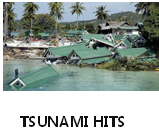The Daily News
By Robert Woodhouse Monday, 27 December 2004
The most powerful earthquake in the past 40 years caused a tsunami(海啸)that crashed into coastlines across Asia yesterday, killing more than 6,500 people in Indonesia, India, Thailand, Malaysia, and at least four other countries. Fishermen, tourists, hotels, homes, and cars were swept away by huge waves caused by the strong earthquake that reached a magnitude of 9.0. The undersea quake struck around 7:00 a.m., Sunday off the west coast of Indonesia’s Sumatra Island. In that area alone, at least 1,870 people were killed.

In Sri Lanka, some 1,600 kilometres west of the quake centre, the number of deaths stood at 2,498, and one million more were affected by the tsunami, government officials said. Indian officials said as many as 1,900 had been killed along the southern coast. Another 254 were found dead in Thailand and 54 in three other countries. In southern Thailand, 1,900 people were hurt and many more were missing, local officials said. “I was having breakfast with my three children when water started filling my home. We had to leave everything and run to safety,” said Chandra Theeravit, a local Thai woman.
Thousands of people are still missing, and the number of deaths is expected to grow even higher over the next few days. Foreign aid is being organised for the tsunami-hit countries. However, dangerous conditions and damaged roads will make it difficult to deliver food and supplies.
【小题1】When did the tsunami happen ?| A.On 25 December 2004. | B.On 26 December 2004. |
| C.On 27 December 2004. | D.On 28 December 2004. |
| A.A powerful earthquake. | B.Water pollution. |
| C.Global warming. | D.Human behaviour. |
| A.Because the aid from foreign countries was not enough. |
| B.Because the number of deaths was expected to grow higher. |
| C.Because more work was needed to search for missing people. |
| D.Because the condition was dangerous and roads were damaged. |


